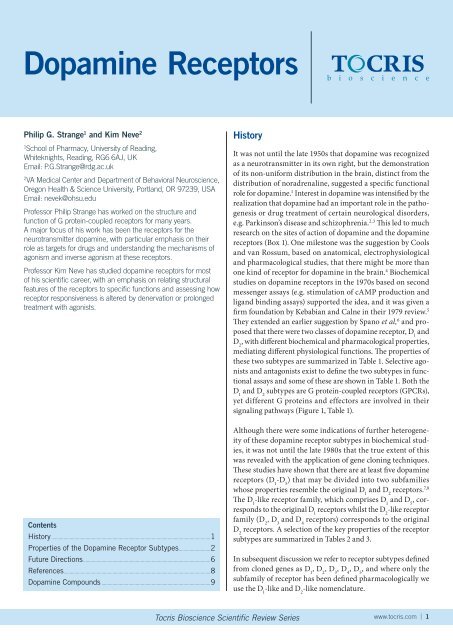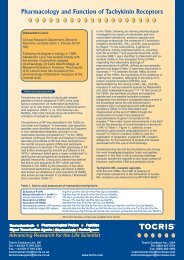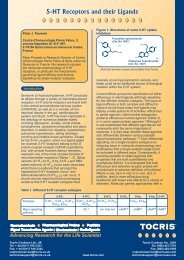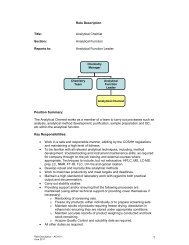Dopamine Receptors - Tocris Bioscience
Dopamine Receptors - Tocris Bioscience
Dopamine Receptors - Tocris Bioscience
You also want an ePaper? Increase the reach of your titles
YUMPU automatically turns print PDFs into web optimized ePapers that Google loves.
<strong>Dopamine</strong> <strong>Receptors</strong>Philip G. Strange 1 and Kim Neve 21School of Pharmacy, University of Reading,Whiteknights, Reading, RG6 6AJ, UKEmail: P.G.Strange@rdg.ac.uk2VA Medical Center and Department of Behavioral Neuroscience,Oregon Health & Science University, Portland, OR 97239, USAEmail: nevek@ohsu.eduProfessor Philip Strange has worked on the structure andfunction of G protein-coupled receptors for many years.A major focus of his work has been the receptors for theneurotransmitter dopamine, with particular emphasis on theirrole as targets for drugs and understanding the mechanisms ofagonism and inverse agonism at these receptors.Professor Kim Neve has studied dopamine receptors for mostof his scientific career, with an emphasis on relating structuralfeatures of the receptors to specific functions and assessing howreceptor responsiveness is altered by denervation or prolongedtreatment with agonists.ContentsHistory...................................................................................................................................1Properties of the <strong>Dopamine</strong> Receptor Subtypes..........................2Future Directions........................................................................................................6References........................................................................................................................8<strong>Dopamine</strong> Compounds..........................................................................................9HistoryIt was not until the late 1950s that dopamine was recognizedas a neurotransmitter in its own right, but the demonstrationof its non-uniform distribution in the brain, distinct from thedistribution of noradrenaline, suggested a specific functionalrole for dopamine. 1 Interest in dopamine was intensified by therealization that dopamine had an important role in the pathogenesisor drug treatment of certain neurological disorders,e.g. Parkinson’s disease and schizophrenia. 2,3 This led to muchresearch on the sites of action of dopamine and the dopaminereceptors (Box 1). One milestone was the suggestion by Coolsand van Rossum, based on anatomical, electrophysiologicaland pharmacological studies, that there might be more thanone kind of receptor for dopamine in the brain. 4 Biochemicalstudies on dopamine receptors in the 1970s based on secondmessenger assays (e.g. stimulation of cAMP production andligand binding assays) supported the idea, and it was given afirm foundation by Kebabian and Calne in their 1979 review. 5They extended an earlier suggestion by Spano et al, 6 and proposedthat there were two classes of dopamine receptor, D 1andD 2, with different biochemical and pharmacological properties,mediating different physiological functions. The properties ofthese two subtypes are summarized in Table 1. Selective agonistsand antagonists exist to define the two subtypes in functionalassays and some of these are shown in Table 1. Both theD 1and D 2subtypes are G protein-coupled receptors (GPCRs),yet different G proteins and effectors are involved in theirsignaling pathways (Figure 1, Table 1).Although there were some indications of further heterogeneityof these dopamine receptor subtypes in biochemical studies,it was not until the late 1980s that the true extent of thiswas revealed with the application of gene cloning techniques.These studies have shown that there are at least five dopaminereceptors (D 1‐D 5) that may be divided into two subfamilieswhose properties resemble the original D 1and D 2receptors. 7,8The D 1-like receptor family, which comprises D 1and D 5, correspondsto the original D 1receptors whilst the D 2-like receptorfamily (D 2, D 3and D 4receptors) corresponds to the originalD 2receptors. A selection of the key properties of the receptorsubtypes are summarized in Tables 2 and 3.In subsequent discussion we refer to receptor subtypes definedfrom cloned genes as D 1, D 2, D 3, D 4, D 5, and where only thesubfamily of receptor has been defined pharmacologically weuse the D 1‐like and D 2‐like nomenclature.<strong>Tocris</strong> <strong>Bioscience</strong> Scientific Review Serieswww.tocris.com | 1
<strong>Tocris</strong> <strong>Bioscience</strong> Scientific Review SeriesBox 1: <strong>Dopamine</strong> receptor productsBox 1 | <strong>Dopamine</strong> synthesis and metabolismHOHO<strong>Dopamine</strong> (3548)Endogenous dopaminereceptor agonistNH 2NO 2 OO NHOHNPEC-caged-dopamine (3992)Caged version of dopamineSO 2 MeOHin the human population with variants containing differentlength insertions in I3. 16,17 In some cases, these D 2-like receptorvariants may have differential abilities to couple to or activateG proteins, 18,19 and may also exhibit slightly different pharmacologicalproperties. 16,20,21 Lines of mice have been developed inwhich the I3 insertion that produces the long D 2receptor variant(D 2L) is deleted, resulting in the expression of only the shortvariant (D 2S). Characterization of these mice suggests that thesplice variants are not fully interchangeable; some D 2receptorresponses are not observed in mice that express only D 2S. 22-24The variants of the D 4receptor have not been found to exhibitany substantive differences in agonist signaling or in couplingto G proteins. 25HOHONH 2L-DOPA (3788)<strong>Dopamine</strong> precursorCO 2 HHNOSU 6162 (2599)<strong>Dopamine</strong> stabilizerThe individual properties of the different subtypes were initiallyprobed by expressing the receptors in recombinant cellsand examining the localization of the subtypes at the mRNAand protein level. More recently, the use of subtype-selectivedrugs and transgenic mice with one or more receptor subtypesgenetically deleted has enabled further study of these receptors.Properties of the <strong>Dopamine</strong> Receptor SubtypesCommon receptor propertiesAnalysis of the amino acid sequences of the dopamine receptorsubtypes has shown that significant homologies exist amongthe subtypes, with the greatest being found between membersof either subfamily. 7,8 Each receptor has been shown to containseven stretches of amino acids that are hydrophobic and longenough to span the membrane. It seems therefore that eachof the dopamine receptors conforms to the general structuralmodel for a GPCR, 9-11 with an extracellular amino terminusand seven putative membrane spanning α-helices linked byintracellular and extracellular protein loops (Figure 2). One ormore potential sites for glycosylation are found on the aminoterminus and second extracellular loop. The helices are bundledtogether in the membrane to form the ligand binding site(Figure 2); some information is available on the residues thatmake contact with ligands. 11,12 There is an intracellular carboxylterminus, probably bearing a palmitoyl group, which may forma further link to the membrane. The D 1‐like receptors haveshort third intracellular loops and long carboxyl terminal tails,whereas the D 2‐like receptors have long third intracellular loopsand short carboxyl terminal tails. This provides a structuralbasis for the division of the receptors into two subfamilies butis also likely to have a functional significance, possibly relatedto the specificity of receptor/G protein interaction.The third intracellular loop, termed ‘I3’, is important for theinteraction of the receptor and G protein. For the D 2‐likereceptors, variants of the subtypes exist based on this loop. Forexample, there are short and long splice variants of the D 2andD 3receptors with the long forms having an insertion (29 aminoacids for the long D 2, D 2L) in this loop. 13,14 Polymorphic variantsof the D 2receptor have been described with single aminoacid changes in I3. 15 The D 4receptor is highly polymorphicIndividual receptor propertiesThe dopamine receptor subtypes exhibit different propertiesin terms of their pharmacological profile, localization,and mechanism of action; these differences will be brieflysummarized below.D 1-like receptorsBoth the D 1and D 5receptors show pharmacological propertiessimilar to those of the original pharmacologically defined D 1receptor, that is, a high affinity for the benzazepine ligands SCH23390, SCH 39166, and SKF 83566, which are selective antagonistsfor these subtypes. Although not as selective for D 1overD 2as the benzazepine antagonists, LE 300 is a potent D 1‐likeantagonist that is useful because it is structurally distinctfrom the benzazepines. Thioxanthines such as flupentixol andFigure 1 | Regulation of adenylyl cyclase by D 1and D 2dopaminereceptors<strong>Dopamine</strong>βγGα sD 1-like receptorAC+ –ATPcAMPD 2-like receptor<strong>Dopamine</strong>Gα i/oThe diagram shows the effects of dopamine to stimulate or inhibitadenylyl cyclase (AC) via the D 1-like receptor and G protein Ga sorthe D 2-like receptor and G protein Ga i/o, respectively.βγ2 |
<strong>Dopamine</strong> <strong>Receptors</strong>Table 1 | <strong>Dopamine</strong> receptor subtypes defined from physiological, pharmacological, and biochemical studiesPhysiological FunctionsBiochemical ResponsesD 1-like <strong>Receptors</strong>Aspects of motor and cognitive function (brain),cardiovascular functionAdenylyl cyclase↑Phospholipase C↑LocalizationCaudate nucleus, putamen, nucleus accumbens,olfactory tubercle, cerebral cortex, cardiovascularsystemReceptor Antagonists SCH 23390SCH 39166SKF 83566LE 300Receptor Agonists A 77636SKF 38393SKF 81297A 68930SKF 81297DoxanthrineRadioligands [ 3 H]-SCH 23390*[ 125 I]-SCH 23982D 2-like <strong>Receptors</strong>Aspects of motor function and behavior (brain), control of prolactin andα-MSH secretion from pituitary, cardiovascular functionAdenylyl cyclase↓K + channel activity↑Ca 2+ channel activity↓GSK-3b↑Caudate nucleus, putamen, nucleus accumbens, olfactory tubercle,cerebral cortex, anterior and neurointermediate lobes of pituitary gland,cardiovascular systemDomperidoneNemonaprideRaclopride(S)-(-)-SulpiridePHNOQuinpiroleN-0437RotigotineSumanirole[ 3 H]-Nemonapride (YM-09151-2)[ 3 H]-Raclopride[ 3 H]-Spiperone**(Bold text denotes compounds available from <strong>Tocris</strong> at time of publication)The localization data are from functional and ligand-binding studies on dispersed tissues and tissue slices. *[ 3 H]-SCH 23390 can also bind to 5-HT 2receptors if present;**[ 3 H]-Spiperone can also bind to 5-HT 1A, 5-HT 2receptors, and α 1‐adrenoceptors if present.phenothiazines such as fluphenazine also show high affinity butare not selective for D 1-like over D 2-like receptors. The developmentof the first D 1-like receptor agonist, SKF 38393, wasimportant for differentiating between activation of D 1‐like andD 2‐like receptors, although it was later realized that the partialagonist nature of SKF 38393 produced an under-appreciation ofthe contribution of D 1-like receptors to behavior. 26 The D 1‐likereceptors show moderate affinities for typical dopamine agonistssuch as apomorphine; full and/or selective D 1-like receptoragonists such as such as A 77636, A 68930, SKF 81297, dihydrexidine,and doxanthrine are now available (Box 2). Thereare minor differences in the affinities of some compounds forthe D 1and D 5receptors (higher agonist and lower antagonistaffinities for D 5), but no compounds that effectively distinguishbetween those subtypes are as yet available. 27,28D 1receptors are found at high levels in the typical dopaminerichregions of brain such as the neostriatum, substantia nigra,nucleus accumbens, and olfactory tubercle, whereas the distributionof the D 5receptors is much more restricted (Table 2);this subtype is found generally at much lower levels. Bothreceptors are able to stimulate adenylyl cyclase (Figure 1), withthe D 5receptor showing some constitutive activity for thisresponse. 28 Inverse agonist activity at the D 1and D 5receptorsis seen in recombinant systems for some compounds such asbutaclamol, 28 which were previously considered to be antagonists.It has been known for some time that stimulation of aD 1-like receptor leads to activation of phospholipase C 29 andrecently this response has been linked to the D 1/D 2receptorheterodimer, providing a function for heterodimer formation. 30Agonists that preferentially stimulate the cAMP response(SKF 83822) or the phospholipase C response (SKF 83959)associated with D 1-like receptors have been described. 31The D 1receptor seems to mediate important actions ofdopamine to control movement, cognitive function, andcardio vascular function. Direct interactions between D 1‐likereceptors and ion channel-linked receptors have been described(D 1/NMDA, D 5/GABA A), 32 leading to modulation of receptorfunction. These interactions provide for cross talk between fastand slow neurotransmitter systems and may point towards afurther functional role for the D 5receptor, which is not wellunderstood. Studies with null mutant ‘knock-out’ mice havesuggested that in some respects, the functions of the D 1andD 5receptors are reciprocal – for example, with respect tospontaneous locomotion – and in other respects similar, forexample with respect to grooming or psychostimulant-inducedlocomotion. 33,34D 2-like receptorsOverall, the D 2, D 3and D 4receptors exhibit pharmacologicalproperties similar to those of the originally defined D 2receptor;that is, they all show high affinities for drugs such as thebutyrophenones (haloperidol, spiperone) and substitutedbenzamides (sulpiride, raclopride), and these classes of drugsprovide selective antagonists for D 2-like receptors over D 1-likereceptors (Table 3). As indicated above, the D 2‐like receptorsalso show high affinities for phenothiazines and thioxanthines.Each D 2‐like receptor has its own pharmacological signature,so there are some differences in affinities of drugs for the individualD 2‐like receptors (Box 3). For example, sulpiride andraclopride show high affinity for the D 2and D 3receptors butwww.tocris.com | 3
<strong>Tocris</strong> <strong>Bioscience</strong> Scientific Review SeriesBox 2: D 1/D 5receptorsFigure 2 | Schematic representation of a G protein-coupleddopamine receptorBox 2 | D 1/D 5receptorsNH 2H 2NDisulfide bondE1E2E334256 71Extracellular spaceHOOHA 77636 (1701)Potent, selective D 1-like agonist;orally activeClONMeHOHOHDihydrexidine (0884)Full D 1-like agonistHOClNHHPI3I2PI1PalmitoylgroupHOHSCH 23390 (0925)Standard selective D 1-like antagonist.Also 5-HT 2CagonistSCH 39166 (2299)High affinity D 1/D 5receptor antagonistNMeHOOCPPCytoplasmOHMeNClOHThe diagram shows the seven helices bundled together in themembrane and the intra- (I1, I2, I3) and extracellular (E1, E2, E3)loops. The ligand binding site is contained in the cavity formedbetween the helices. There may be an eighth helix formed in thecarboxyl terminus parallel to the membrane (not shown). There isalso a disulfide bond between E2 and the top of helix 3. The heliceshave been drawn parallel to one another for clarity but in fact thereare kinks in the helices and they are not fully parallel. I3 and thecarboxyl terminus contain multiple sites for phosphorylation that areinvolved in regulation of receptor responsiveness and interactionswith adapter proteins.a lower affinity for the D 4receptor (Box 4). Clozapine displaysmoderate selectivity for the D 4receptor. Most D 2antagonistsshow a higher affinity for the D 2receptor compared with the D 3and D 4receptors; this is because the D 2receptor, being overallmuch more abundant in brain than the other D 2‐like receptors,corresponds to the pharmacologically defined D 2‐like receptorfor which these drugs were developed. The molecular cloning ofadditional D 2‐like receptors enabled the development of moreselective antagonists that are invaluable in determining thefunctions of these subtypes. For example, L‐741,626, NGB 2904,and L‐745,870 are D 2selective (~40-fold), D 3selective (~200‐fold)and D 4selective (~2000-fold) antagonists respectively. 35,36Selective agonists for the D 2-like receptors relative to the D 1‐likereceptors, e.g. N‐0437, PHNO, and quinpirole, have been developed.Sumanirole is a full-efficacy agonist that is highly selectivefor the D 2receptor over other dopamine receptors. 37 Thereare a number of D 4agonists of varying efficacy and selectivity,with A 412997 being an example of a highly selective fullHNClSKF 81297 (1447)D 1-like agonistOHD 4agonist (Box 5). 38 Many agonists appear to be highly selectivefor the D 3receptor over other D 2-like receptors in radioligandbinding assays, but this frequently reflects an invalidcomparison between a mixed population of agonist high- andlow‐affinity D 2receptors, and the D 3receptor that is apparentlyconstrained in an agonist-high affinity conformation, 39 ratherthan a difference in drug concentrations capable of activatingthe two subtypes. 40 When care is taken to compare functionalresponses or binding to the agonist high-affinity state of thereceptors, dopamine and some agonists such as pramipexoleare determined to be modestly D 3selective. 41The D 2receptor is the predominant D 2‐like subtype in the brain,located at high levels in typical dopamine rich brain areas. D 3and D 4receptors are found at much lower levels and in a morerestricted distribution pattern, located predominantly in limbicareas of the brain (Table 2). Some D 3receptors are also found inregions associated with motor function such as the putamen.The D 2‐like receptor subtypes have each been shown to inhibitadenylyl cyclase (Figure 1) when expressed in recombinantcells, 40,42,43 although the signal via the D 3receptor has provenmore difficult to demonstrate and is generally lower than for theother two subtypes. This may relate to preferential coupling ofthe D 3receptor to specific adenylyl cyclase isoforms. 44MeOHSKF 83959 (2074)D 1-like partial agonist4 |
<strong>Dopamine</strong> <strong>Receptors</strong>Table 2 | <strong>Dopamine</strong> receptor subtypes identified by molecular biological studiesD 1-likeD 2-likeD 1D 5D 2S/LD 3D 4Amino Acids 446 (human, rat) 477 (human)414/443 (human) 400 (human)387 (human*, rat)475 (rat)415/444 (rat)446 (rat)Homologywith D 1with D 2(short)100%44%82%49%44%100%44%76%42%54%LocalizationCaudate/putamen,nucleus accumbens,olfactory tubercle,hypothalamus,thalamus, frontalcortexHippocampus, thalamus,lateral mamillary nucleus,striatum, cerebral cortex(all low)Caudate/putamen,nucleus accumbens,olfactory tubercle,cerebral cortex (low)Nucleus accumbens,olfactory tubercle,islands of Calleja,putamen (low),cerebral cortex (low)Frontal cortex, midbrain,amygdala, hippocampus,hypothalamus, medulla(all low), retinaResponse Adenylyl cyclase↑ Adenylyl cyclase↑ Adenylyl cyclase↓ Adenylyl cyclase↓ Adenylyl cyclase↓Introns in Gene None None Yes Yes YesOrganization of AminoAcid SequenceThird intracellular loopCarboxyl terminal tailShortLongShortLongLongShortLongShortLongShortReference 65 27 66 67 68The properties of the principal dopamine receptor subtypes identified by gene cloning are shown. They are divided into ‘D 1-like’ and ‘D 2-like’ groups to reflect amino acid homology,functional similarity, structural similarity, and pharmacological properties. This grouping conforms with a previous classification based on pharmacological and biochemical properties(Table 1). D 2Sand D 2Lrefer to different alternatively spliced forms of the D 2receptor gene. The homology values are for the transmembrane-spanning regions. 69 The localizationsand relative expression levels shown are the principal ones known at present from in-situ hybridization and use of the polymerase chain reaction. Some pharmacological data for thedifferent receptor subtypes is given in Table 3. *The human D 4receptor has many longer allelic variants. For further information on the properties of the dopamine receptor subtypes,please consult reference 8.The D 2‐like receptors will, upon activation, stimulate a rangeof processes including acute signaling events (inhibition ofadenylyl cyclase, stimulation of K + channels, inhibition of Ca 2+channels, stimulation of arachidonic acid release) and longerterm events (MAP kinase and β‐arrestin-2/Akt/GSK‐3 signaling,and mitogenesis). 45,46 D 3receptor-mediated signalingevents are often of lower magnitude than for the other D 2-likereceptors. The relation of these signaling events to in vivoresponses is only beginning to be clarified. Many compoundsthat were thought to be antagonists at D 2‐like receptors – suchas the antipsychotic drugs haloperidol, chlorpromazine, andTable 3 | Pharmacological properties of the dopamine receptorsubtypesDrugReceptor Affinity, K i(nM)D 1D 5D 2D 3D 4Chlorpromazine 73 133 0.55 1.2 9.7Clozapine 141 250 35 83 22<strong>Dopamine</strong> † 2340 228 1705 27 450Haloperidol 27 48 0.53 2.7 2.3Raclopride >72000 – 1 1.8 2400SCH 23390 0.35 0.3 267 314 3560SCH 39166 1.2 2 980 – 5520SKF 83566 0.3 0.4 2000 – –(S)-(-)-Sulpiride 36000 77000 2.5 8 1000clozapine – have been shown to possess inverse agonist activityat D 2and D 3receptors. 47-49 This inverse agonism may contributeto the increases in D 2receptor number seen in the brainwhen experimental animals are treated chronically with thesedrugs.The D 2receptor is important for mediating the effects ofdopamine to control movement, certain aspects of behavior inthe brain and prolactin secretion from the anterior pituitaryBox 3: D 2receptorsBox 3 | D 2receptorsL-741,626 (1003)High affinity D 2antagonist(-)-Quinpirole (1061)Selective D 2-4agonistNHNHNHHNNNHMeOHClValues for the dissociation constants are given for ligands, determined using ligandbinding assays for the five dopamine receptor subtypes. As far as possible, valuesare given that avoid artefacts present in ligand binding assays with high affinityradioligands. 3 † Data for dopamine were obtained in the presence of Gpp(NH)p andtherefore represent the agonist low-affinity state. Data taken from references 3, 8, 21,27 and 70.Sumanirole (2773)D 2-selective agonistHNNOwww.tocris.com | 5
Box 4: D 3receptors<strong>Tocris</strong> <strong>Bioscience</strong> Scientific Review SeriesBox 4 | D 3receptorsEt O OHNNHMeOEtClClNNOONNNClNEticlopride (1847)Selective D 2/D 3antagonist (D 3> D 2)PG 01037 (3887)D 3receptor selective antagonistNHPiribedil (1031)D 2/D 3receptor agonist (D 3> D 2)OHOONHNSNNHNOONNH 2NCN(+)-PD 128907 (1243)D 3agonist (D 3≥ D 2> D 4)Pramipexole (4174)Selective D 3agonistSB 277011A (4207)Selective D 3antagonistBox 5: D 4receptorsBox 5 | D 4receptorsHNOA 412997 (4552)Selective D 4agonistNNMeNgland. The functions of the D 3and D 4receptors are currentlyunknown, although their localizations in limbic areas of brainsuggest roles in cognitive, emotional, and behavioral function.These properties have made them attractive targets for thedesign of potential selective antipsychotic drugs. The D 2‐likereceptors show high affinities for most of the drugs used totreat schizophrenia (antipsychotics) and Parkinson’s disease(e.g. bromocriptine). 3 L‐745,870 was the first highly selectiveD 4antagonist synthesized, but it proved to be inactive againstthe psychosis of schizophrenia. 50ClONFuture DirectionsNNHL-745,870 (1002)Highly selective D 4antagonistNNMeL-741,742 (1004)Highly selective D 4antagonistClONHPD 168077 (1065)High affinity, selective D 4agonistNNCNUnderstanding the role of the dopamine receptor subtypesWe are still a long way away from understanding the role ofthe different receptor subtypes. Although partially selectiveantagonists and transgenic ‘receptor knock out’ animals areavailable for some of the subtypes, much is still to be done here(see for example Waddington et al (2005) 31 ).<strong>Dopamine</strong> receptor subtypes in drug discoveryDue to the importance of dopamine for the pathogenesis ordrug treatment of several important disorders e.g. Parkinson’sdisease, schizophrenia and pituitary prolactin dysfunction,dopamine receptors have been very popular as targets for drugdiscovery campaigns (Box 6). This continues to be the case andindications have expanded into areas such as drug dependenceand penile erectile dysfunction. A new development in thesearch for effective antipsychotics has been the development ofdopamine D 2‐like partial agonists such as aripiprazole. 51 It hadbeen thought that antipsychotics had to be antagonists/inverseagonists at the D 2receptor, 3 yet the effective use of D 2partialagonists as antipsychotics raises questions about the mechanismof D 2receptor-mediated antipsychotic activity that need6 |
<strong>Tocris</strong> <strong>Bioscience</strong> Scientific Review SeriesCat. No. Product Name Primary ActionD 3<strong>Receptors</strong>2132 Amisulpride Selective D 2/D 3receptor antagonist; atypical antipsychotic agent0427 Bromocriptine Selective D 2/D 3agonist (D 3> D 2)0706 7-Hydroxy-DPAT <strong>Dopamine</strong> agonist (D 3≥ D 2= D 4)1847 Eticlopride Selective D 2/D 3antagonist (D 3> D 2)1109 GR 103691 Highly selective D 3antagonist3940 GSK 789472 D 3antagonist. Also D 2partial agonist1347 Nafadotride Highly potent, preferential D 3antagonist2635 NGB 2904 Potent and selective D 3antagonist1243 (+)-PD 128907 D 3agonist (D 3≥ D 2> D 4)3887 PG 01037 D 3receptor selective antagonist0719 7-Hydroxy-PIPAT D 3agonist (D 3> D 2)1031 Piribedil D 2/D 3receptor agonist (D 3> D 2)3355 PNU 177864 Highly selective D 3antagonist4174 Pramipexole Selective D 3agonist1519 Quinelorane D 2and D 3agonist1061 (-)-Quinpirole Selective D 2-4agonist1810 Raclopride Potent, selective D 2/D 3antagonist3680 Ropinirole Selective D 2-like agonist (D 3> D 2> D 4)3896 Rotigotine <strong>Dopamine</strong> D 2/D 3agonist4207 SB 277011A Selective D 3antagonist0895 (S)-(-)-Sulpiride Selective D 2-like receptor antagonist (D 3> D 2> D 4)1357 U 99194 Potent, selective D 3antagonistD 4<strong>Receptors</strong>4552 A 412997 Selective D 4agonist2214 ABT 724 Potent, selective D 4partial agonist; proerectile0444 Clozapine <strong>Dopamine</strong> antagonist with some D 4selectivity. Also 5-HT 2A/2Cantagonist0782 2-CMDO D 4/D 2antagonist2645 Fananserin D 4antagonist. Also 5-HT 2Aantagonist1004 L-741,742 Highly selective D 4antagonist1002 L-745,870 Highly selective D 4antagonist3298 NGD 94-1 Selective D 4receptor ligand1065 PD 168077 High affinity, selective D 4agonist3529 PD 168568 Potent and selective D 4antagonist2735 PNU 96415E D 4and 5-HT 2Aantagonist; antipsychotic1061 (-)-Quinpirole Selective D 2-4agonist2329 Ro 10-5824 Selective D 4receptor partial agonist4185 Sonepiprazole Selective D 4receptor antagonist<strong>Dopamine</strong> <strong>Receptors</strong> (Non-selective)0678 (+)-AJ 76 <strong>Dopamine</strong> receptor antagonist; displays preferential action at D 2-like autoreceptors2073 (R)-(-)-Apomorphine <strong>Dopamine</strong> receptor agonist; non-subtype-selective3737 Asenapine Novel antipsychotic agent; dopamine receptor antagonist0474 Dihydroergocristine Partial dopamine receptor agonist. Also partial adrenergic agonist and 5-HT antagonist3548 <strong>Dopamine</strong> Endogenous agonist at dopamine D 1-5receptors4057 Flupenthixol <strong>Dopamine</strong> receptor antagonist4052 Lisuride <strong>Dopamine</strong> receptor agonist; antiparkinson’s agent10 |
<strong>Dopamine</strong> <strong>Receptors</strong>Cat. No. Product Name Primary Action1644 Mesulergine <strong>Dopamine</strong> receptor partial agonist. Also 5-HT 2Aand 5-HT 2Cantagonist0937 Pimozide D 2-like antagonist. Also binds with high affinity to 5-HT 7receptor. Ca 2+ channel blocker1559 Roxindole <strong>Dopamine</strong> D 2autoreceptor agonist. Also displays affinity for D 3, D 4, 5-HT 1Areceptors and5-HT transporters3070 Thioridazine <strong>Dopamine</strong> receptor antagonist; antipsychotic<strong>Dopamine</strong> Transporters4357 Bicifadine Noradrenaline, 5-HT and dopamine re-uptake inhibitor4798 (S)-Duloxetine Potent 5-HT and noradrenaline reuptake inhibitor; also blocks dopamine reuptake0513 GBR 12783 Potent, selective dopamine uptake inhibitor0421 GBR 12909 Selective dopamine uptake inhibitor. Also s ligand4351 JHW 007 High affinity dopamine uptake inhibitor2742 Reserpine Inhibitor of vesicular monoamine transport2175 Tetrabenazine Potent inhibitor of vesicular monoamine transport; depletes dopamine storesRelated Products2813 D-Amphetamine Induces dopamine, 5-HT and noradrenaline release3788 L-DOPA <strong>Dopamine</strong> precursor2547 6-Hydroxydopamine Selective catecholaminergic neurotoxin3992 NPEC-caged-dopamine Caged version of dopamine (Cat. No. 3548)2599 OSU 6162 <strong>Dopamine</strong> stabilizer0730 4-Phenyl-1,2,3,4-tetrahydroisoquinolone <strong>Dopamine</strong> release inhibitorFor a complete and up-to-date product listing please visit www.tocris.comwww.tocris.com | 11
© 2013 <strong>Tocris</strong> Cookson, Ltd.www.tocris.comUSA & CanadaR&D Systems, Inc.614 McKinley Place NEMinneapolisMN 55413, USAPhone: (800) 343-7475 (612) 379-2956Fax: (612) 656-4400info@RnDSystems.comUK & EuropeR&D Systems Europe, Ltd.19 Barton LaneAbingdon Science ParkAbingdon, OX14 3NB, UKPhone: +44 (0) 1235 529449Fax: +44 (0) 1235 533420info@RnDSystems.co.ukChinaR&D Systems China Co., Ltd.24A1 Hua Min Empire Plaza726 West Yan An RoadShanghai, PRC 200050Phone: +86 (21) 52380373Fax: +86 (21) 52371001info@RnDSystemsChina.com.cn<strong>Tocris</strong> is an R&D Systems companyFor a full list of international distributors, please visit www.tocris.com/distributors







